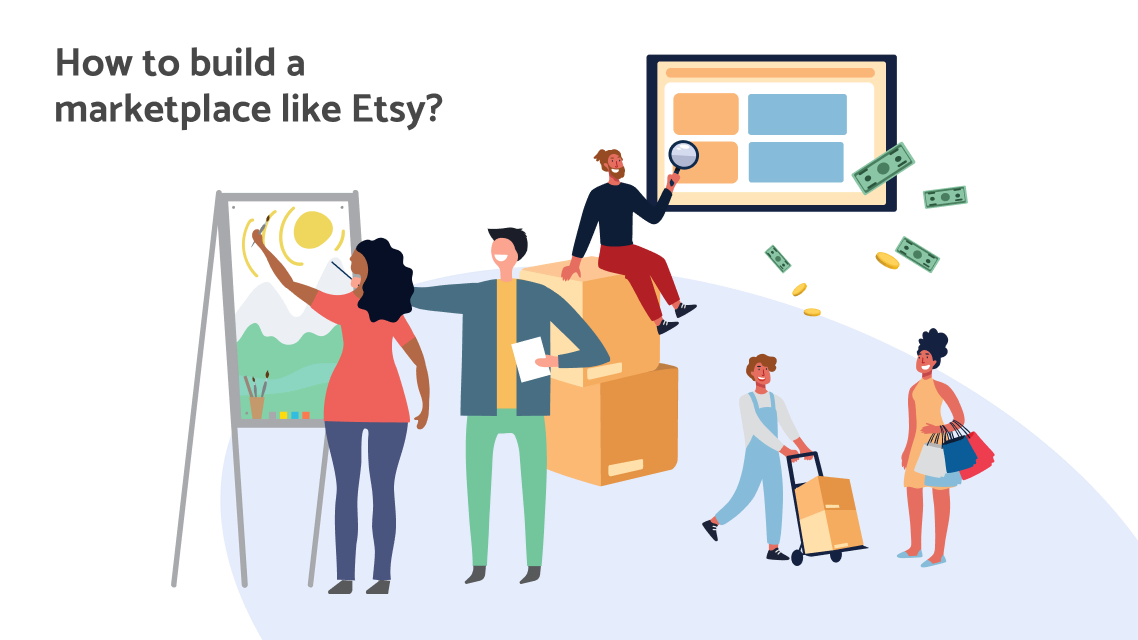Etsy has already become the number one service in its category. Millions of users worldwide visit https://www.etsy.com/ to purchase hand-made accessories, unique furniture, vintage clothing and more. In 2017 Etsy’s revenue reached $441 million.
This is what success looks like! And many entrepreneurs aim to repeat the platform’s achievement by creating their own marketplace like Etsy. While the competition is fierce, only a few services out there will get what they are after – sales.
We have studied the business models and technical implementation of creating the next Etsy. We already know the secret of how to build a marketplace like Etsy. And you deserve to know as well! This article features an extensive step-by-step guide for marketplace development within the creative industry. Don’t miss it!
What is Etsy?
Etsy is a special marketplace. Instead of the cheap or low-quality mass-market products pedaled by other online retail giants, Etsy focuses on unique handcrafted items.
Who uses Etsy? The marketplace targets creative people by allowing them to present their works to the world.
The typical Etsy user might crochet, carve or sew for a living. They might work out of a home or professional studio, develop new furniture or home décor collections, or invest in advertising. For sellers, Etsy is first and foremost a sales channel – a unique opportunity to export their goods to other countries and even continents.
Etsy’s sellers also consist of another group. Members of this group are lawyers, doctors, or high-school teachers who create and sell their wares in their free time.
Etsy has attracted the right clients for both seller groups. The platform’s buyers prefer to use items with soul in their household. They are ready to order products from overseas if they like what a seller has to offer.
.webp)
Why are marketplaces like Etsy so popular?
There are a few reasons why Etsy and other similar platforms continue to attract sellers and buyers:
-
Exclusive goods
Etsy only allows listings of hand-made or vintage items. You can’t buy a purse from Zara’s previous collection. Instead, buyers can browse a wide selection of unique accessories. These are either handcrafted (and therefore one-of-a-kind) or were created decades ago. Those who purchase an item with history and soul from Etsy don’t typically return to mass market stores. The statistics proves this fact: 81% of Etsy buyers return to the platform to make repeat purchases. -
P2P commerce
On Etsy, buyers don’t talk to a company through an SMM or support manager. Instead, the platform fosters warm, personal communication between buyers and creators. -
Community
Etsy is not just about commerce; its about communication and exchange. The company has invested heavily in developing a strong international community of creators. The site allows like-minded people to meet, exchange experiences, and motivate and inspire each other. This is one benefit no other online marketplace has yet been able to offer artists and art lovers.
.webp)
Etsy is primarily a web application, but the platform also has mobile apps for iOS and Android. Currently, around 67% of traffic comes from mobile devices, and this number will rise.
When building an online marketplace like Etsy, don’t ignore or bypass mobile application development, even if you don’t think there’s room in the budget. It’s best to opt for hybrid app development. This approach allows you to reuse code and create a website and mobile app like Etsy for various platforms in a short time.
How to create an online marketplace like Etsy: 4 main stages
Now that we’ve reviewed the main strengths of Etsy’s marketplace, let’s consider the steps you’ll need to take to create marketplace software like Etsy from scratch.
Stage 1. Research and analysis
You should never jump into the development process straight away. Preparation and strategy will be your best friends if you want to build a marketplace like Etsy that wins as much or more success. But what should your research focus on?
-
Competitor analysis
Etsy is your main competitor, but others exist too. Each has unique features designed to attract customers. Analyze them! Sift through industry-specific forums, read app-store reviews and try the services yourself. These tactics will allow you to recognize competitors’ strengths and identify areas where your future product can set itself apart. -
Buyer persona
“Who do you want to sell to? - “Everyone!”
Is that your answer? If so, you need to change it immediately! When a product or platform tries to target everyone, it usually fails to attract anyone. When offers are too general, they fail to appeal to potential customers. Instead, take the time to define your buyer persona – the ideal customer for your product. Because we’re developing a marketplace, you’ll have to describe at least two personas: the seller and the buyer. The more precisely you define your buyer persona, the more efficient your future marketing campaigns will be. -
Monetization model for your marketplace app
A project can earn money in many ways. Luckily, we’ve already described them in our article about marketplaces. Regardless of the monetization model you select, you will have to project optimal revenue income before starting the development process. Choose between subscription, listing fee and revenue percentage or combine them to make your product more attractive. So did Etsy:
.webp)
Build a business plan
The result of your research and analysis stage will be a business plan – a document that includes all the gathered information about the market. The plan will also need to include your financial details: planned expenses, required investments, and expected revenue.
The right business plan provides a project with a long term vision and uncovers gaps and weaknesses in a venture. Treat your business plan as a chance to predict and eliminate all possible problems with your marketplace.
Stage 2. UX/UI design for an app like Etsy
Because a marketplace must cater to both sellers and buyers, designing a platform can prove quite tricky. But nothing is impossible! With the right management, you will succeed. Focus on these two important points:
-
Start with UX - user experience design
A UX designer is a bit like a psychologist. His aim is to understand user motivation and predict expectations when a user enters your marketplace web app. Finding ways to meet these expectations through efficient design is the UX designer’s core task. A UX professional is responsible for creating an app structure built around a consistent and clear user experience. -
Move on to UI - user interface design
When your app’s blueprint is ready, the UI designer enters the game. To create a marketplace that can beat Etsy, you have to keep in mind client preferences. Choices in color, font, forms, and transitions should all center around your platform’s target audience.
Your UX and UI designers do not (and likely should not) have to be two different professionals. On the contrary, many user interface designers have strong expertise in user experience and can create an efficient design from scratch. All you have to do is outsource your marketplace design to the right person.
By the end of this design stage, you should have a prototype – a model of your future product that you can develop, evaluate and test.
Stage 3. Development and testing
If you’ve thought about how to create an online marketplace like Etsy, you’re probably prepared to implement all of Etsy’s best features straight away. Slow down. A common best-practice in development is to start by creating a minimum viable product (MVP).
Define the core features of your future marketplace. These features should provide the minimal functionality required to satisfy your target user’s inquiry. Aim to develop a simple application as fast as possible and with as little money as possible. Then, start testing this MVP.
Test your MVP marketplace app with potential customers. In this stage, your main aim is to verify that there’s an audience who needs your service. Listen to users, consider their ideas and improve your product.
Even if you copy Etsy’s successful business model and app structure, your venture is far from guaranteed success. First of all, users would have no clear reason to give up a proven marketplace like Etsy for a no-name service.
The development stage will involve extensive communication with the target audience and plenty of brainstorming sessions and experiments. Take the best features of Etsy-like marketplaces, but then add unique functionality and polish it on the battlefield by consulting real, paying customers.
Which technology stack is best for a marketplace like Etsy?
Start with your marketplace’s web app development. This trick can save you much time and money in the future, and here’s how:
A website like Etsy has a wide audience because it works equally well on laptops, tablets, and smartphones (so long as you have thought about adaptability, of course).
After web app development, when you decide to deliver extra functionality by offering users a mobile app, you can opt for cross-platform app development and keep using the same technology stack. This means you won’t have to hire another technical team – your current employees will be able to cope with the task. Some code from your web app may even see reuse for your mobile application. This again reduces development time and therefore cost.
We recommend you to opt for JavaScript-based tools:
Frontend: Angular, React or Vue
Backend: Node.js, or PHP-based Laravel or Symfony
Mobile: Cordova, React Native or Ionic
Stage 4. Support and scaling
At this stage, you’ve released your MVP marketplace platform, but your job is far from complete. Now is when the most interesting part of the project begins. In stage 4, you’ll get the chance to work with real users and see first-hand how your assumptions are validated (or invalidated).
Analyzing user feedback is crucial. User feedback should act as an endless source of inspiration for new ideas, fresh implementations, and interesting integrations. Continue developing your app to attract new customers, but don’t forget about existing ones.
Make sure you provide users with relevant technical and informational support. This will increase user satisfaction and the chances that your service will receive a favorable recommendation.
.webp)
How much does it cost to create a website like Etsy
Development costs vary significantly, but there are a few factors that directly affect the price:
-
App functionality
Because Etsy continuously develops new features, so you won’t just be able to copy their service – it changes over time. Instead, we recommend you start with a set of basic features that fit within an MVP concept. This strategy will enable you to prove your assumptions and strategy are sound at a lower cost. -
Technologies behind the project
Here, you have several choices: develop native mobile apps for iOS and Android, which is quite expensive; save time and money by opting for cross-platform technology; or adhere to a minimal budget and develop a standalone mobile-friendly web app. All approaches have pros and cons that require consideration. -
Your location
Of course, your expenses depend a lot on whether you live in San Francisco or Kyiv. But, even those who live in San Francisco can take advantage of Ukrainian prices. Offshore software development can save you up to 60% off your development budget.
At today’s Ukrainian rates, simple marketplace MVP will cost you $15 000 to $35 000. Meanwhile, an American contractor will likely charge you up to $80 000 for the same amount of work and quality.

If you’re in a situation where you need to make every dollar count, it’s likely a better idea to consider outsourcing app development.
Like this article? Then you'll also like our monthly newsletter! Don't hesitate to subscribe!
And one more thing! We have gathered all the info and visuals from this article into a downloadable infographic. Check it out!
Download a "How to build a marketplace like Etsy" infographic



.webp)
